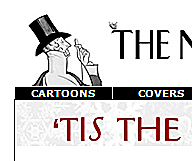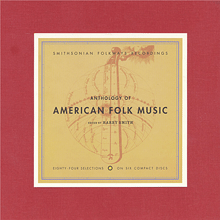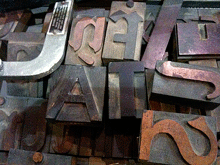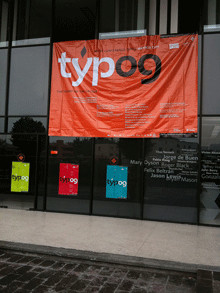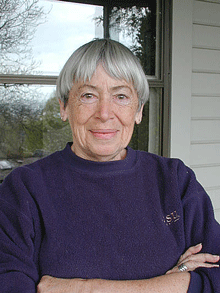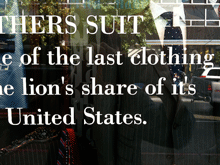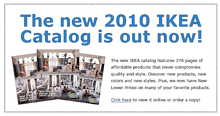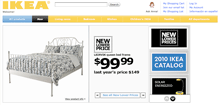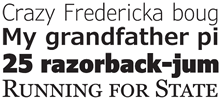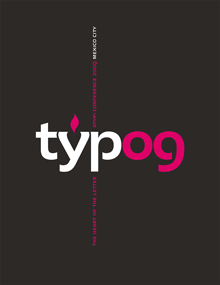The eagle-eyed proofreaders and fact-checkers at The New Yorker clearly didn’t have a go at this pre-Christmas advertisement that came in my e-mail. If I were Eustace Tilley in this image, I’d be peering skeptically not at the butterfly but at the conspicuously backward apostrophe. ’Tis sad, is ’t not?
easilyamused |
Archive for 2009
The great apostrophe turnaround
Published
This morning I was trying to think of the name of the musicologist who compiled the famous 1952 Anthology of American Folk Music. “Harry Something-or-other,” I muttered to myself. The name I wanted was Harry Smith, but what my sieve-like brain came up with instead was Harry Carter. I immediately found myself imagining an alternate history in which noted typographic historian Harry Carter had gone out and conducted field recordings of ephemeral fonts. He would have hunted down an agèd and forgotten Garamond in the back country of northern France, a frail but feisty Bodoni in a village in the Apennines. Carter’s compilation would be credited with sparking the later type revival that swept the coffeehouses and small printshops of post-Eisenhauer America.
All right, my flight of fantasy probably owed more to another musicologist, Alan Lomax, and his father John, who actually did conduct field recordings to an extent that Harry Smith never did. But the imagination isn’t held back by petty fact.
Dublin & Birmingham, Nov. 2009
Published
Last month I went to Dublin, and to Birmingham and London in the UK – so soon after returning from Typ09 in Mexico that it felt as though I was just visiting this interesting city called “Seattle” for a brief time. The main purpose of the trip was to check out venues and talk to organizers for next year’s ATypI conference in Dublin, but the timing was occasioned by my being invited to speak at the one-day Typographic Horizons conference in Birmingham (and incidentally to stay an extra day and address the Chitterlings typographers’ dinner). We flew into and out of London, so we had a chance to see a small sampling of our friends in London, too.
Typographic Horizons was a small but enthusiastic conference, bringing together some of the energy of Birmingham’s design community. Caroline Archer and Alexandre Parré, and the hosts at the Birmingham Institute of Art and Design, have ambitions to make Birmingham a design center. London, of course, is the metropolis, but second-city Birmingham actually finds it easier to attract people from around the country, including London, according to Caroline. And besides, it’s got three-foot-high stone statues of John Baskerville’s punches.
Dublin Castle is a remarkable venue, well set up for conferences of all kinds; and Dublin is a delightful city. We certainly enjoyed the Guinness (“the wine of the country,” as James Joyce called it) and the comfortable pubs that served it. Clare Bell and Mary Ann Bolger, the principal organizers of next year’s conference, were well organized and cheerful hosts; so were their colleagues at the Dublin Institute of Technology, which will be hosting the conference. We saw only a small bit of the city, but enough to be sure that it will be a good site for ATypI; Irish culture is so intimately tied up with literature that naturally the theme of the conference is going to be “The Word.” On the last day, before Mary Ann headed off to the picket lines for a one-day public-service strike, we managed to see the National Print Museum, which is full of presses, type, and printing artifacts of all kinds, as well as printed matter, including one of the few remaining copies of the 1916 proclamation of the Irish Republic.
I’ve posted a few photos from the trip on Flickr. This is just a taste; I took lots of shots of the interior spaces of Dublin Castle, but most of them will only be of interest to the organizers. You’ll see them all – the spaces, that is – when you show up next September for the conference.
Typ09 happened
Published
I was too busy during Typ09, the 2009 ATypI conference in Mexico City, to write anything for this blog (or for much of anything else), but it wasn’t for lack of potential content. The conference was very well attended and full of ideas; everyone I’ve talked to seemed to think that the program was particularly stimulating, and the cultural and intellectual milieu was rich and intense.
Many thanks to the organizers of the conference – especially to Ricardo Salas, the mastermind of the whole event; to the indispensible Mónica Puigferrat and Paulina Rocha; to Marina Garone and Leonardo Vásquez, of the program and exhibitions committees, respectively; to Roger Black, who got the ball rolling; and to Barbara Jarzyna, ATypI’s conference organizer and executive director.
Although I didn’t have time to write anything, I did take a lot of photos. I posted an early batch to Flickr before the conference began, and later added quite a few more. Most of them even have captions! Here they are.
[Photos: Typ09 banner and posters at Anáhuac University (left); Mark Barratt & Simon Daniels at a sidewalk bar in the Centro Histórico (below, top, L–R); one of the multiple screens in the main program at MIDE (below, bottom).]
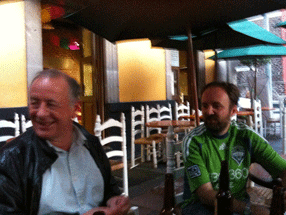
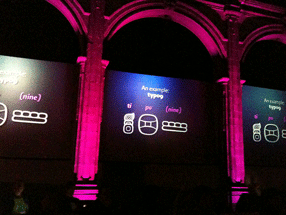
Four score and three cheers
Published
Time to mark one of those arbitrary points on the calendar that mean so much to us. October 21 is the 80th birthday of one of the finest American writers, Ursula K. Le Guin. Her novels have embodied a thoughtfulness, a humanity, and a pragmatic sensibility that have resonated with me since I read the earliest ones when I was just a teenager. Her essays, beginning with The Language of the Night, edited by Susan Wood, joined the most intelligent conversations in print, the ongoing weaving of ideas and their telling that humans have been engaged in since they first had time to speculate.
She’s got a great laugh, too. Happy birthday, Ursula!
[Photo: Ursula Le Guin, by Eileen Gunn]
Elegance & credibility, blown
Published
Brooks Brothers has an amazing ability to project established elegance and solid reliability in the realm of men’s formal clothing. A Brooks Brothers suit is iconic. When Brooks Brothers first established a store in downtown Seattle, a few years back, they managed to make it look as though the shop had been established on that corner since the founding of the company in 1818 – despite the fact that there hadn’t even been a town, much less a street intersection, at that spot nearly two hundred years ago. In the spot they moved to later, a couple of blocks away, the building isn’t quite as convincing, but the shop still has that aura of conservative quality.
Except in the execution of its typography. The choice of Bodoni for the type on this window text was clearly meant to emphasize the classic elegance of the brand. But the effect is spoiled by the typewriter apostrophes, which neither Giambattista Bodoni nor any type designer up until the advent of desktop publishing had ever conceived of. (It’s further spoiled by the fact that the second apostrophe doesn’t even belong there: the adjective is its, not it’s.)
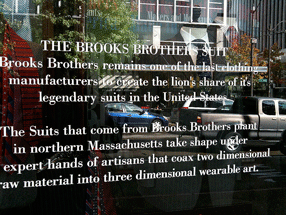
Up against the wall
Published
This striking bit of hortatory graffiti was on the wall of an alley near City Lights Books in North Beach, when I was in San Francisco last week. (No, it wasn’t Kenneth Rexroth Alley, surely the best-named street in America.) The drip-effect may have been unintentional – at least at first – but I could imagine this being the basis for an entire lettering style. Whatever caused it, will or happenstance, it was effective.
The sounds & images of ATypI
Published
A link has just gone up on the ATypI website to a set of videos from the program of the 2007 ATypI conference in Brighton – a selection (not complete) of the talks and presentations that made that conference worth attending. (When I first started listening to one of the recordings, I found myself thinking, “Hey, that sounds like me…!” Of course, as I realized after a few moments, it was me: I did the introduction to the speaker, and that was included in the recording.) It’s a nice, timely reminder of how eclectic and informative an ATypI conference can be. It also gives me a chance (at long last) to catch one or two of the talks that I missed because I was hosting another track at the same time. That won’t be a problem this year, since the main program at Typ09 will be presented in a single continuous track. (“All singing! All dancing!” The Busby Berkeley musical numbers starring John Downer, Erik Spiekermann, and David Berlow will astound and delight!)
Time’s a-wastin’! Register now!
Ikea Verdanarama
Published
It’s amazing when fonts turn up in the news. As everyone in the type business has undoubtedly heard by now, Ikea decided to switch from one typeface to another for its catalogs and ads, and all hell broke loose on Twitter. You wouldn’t think that a typographic design change would generate that much heat, but lots of people (not all of them typographers or graphic designers) have expressed outrage – outrage! – at Ikea’s dropping its longstanding catalog typeface, a custom version of Futura, and replacing it with, of all things, Verdana. Shock! Horror! A web font!
Verdana was designed in the 1990s for Microsoft, developed specifically as a typeface for reading onscreen. The designer, Matthew Carter, has long experience of virtually every kind of typeface technology, and he brought that to bear on designing Verdana. Since text on a computer screen appears, of necessity, at pretty coarse resolution, the outlines of the letters have to be adapted somehow when rendering them at small sizes; there simply aren’t enough pixels available to reproduce the outline shapes perfectly. That’s where the art and craft of designing screen fonts comes in: making the most of those extreme limitations. In what was at the time a revolutionary turnabout, Carter first designed bitmapped letters for each of the target sizes, positioning pixels to get the most legible shapes he could; then he drew the outlines for the higher-resolution letters, based on the shapes of the lo-res bitmaps. Tom Rickner, a wizard of digital font technology, then created the “hints” that would tell the font software exactly how to distort the outlines at a particular size, when drawing a character on the screen, in order to achieve the ideal bitmap at that size.
One of the things that make Verdana legible onscreen, compared with a lot of other typefaces, is the generous space around the characters. There’s always a tendency among web designers to try to cram in as much material as possible in the space available, but that works against clarity and legibility. Without enough space between the letters, they all tend to run together. We’ve all seen this, much too frequently, on our computer screens. The clear, open shapes of Verdana’s letters can vary quite a bit from size to size at small text sizes onscreen, but one thing they have in common is that they’ve been given enough space to breathe.
Although Verdana was meant primarily for onscreen reading, it works surprisingly well on paper as well. It’s a simple, clean, unpretentious sans serif typeface, easy to read. I’ve used it for years as the typeface for manuscripts and drafts of anything I’m writing, because it’s easy to read both onscreen and on paper and it gets out of the way. I realized seven or eight years ago that Verdana had passed into general use, when I saw it on a billboard in San Francisco. (The same characteristics that make it legible onscreen may make it easy to read at a distance as you’re driving by.) I’ve never tried using Verdana in print, but I can imagine situations where I might want to.
It’s funny to see the choice of Verdana lambasted because it was designed for a different purpose. As Erik Spiekermann has pointed out, many of our most versatile typefaces were originally designed for one specific purpose, answering a particular set of constraints (Times New Roman, for instance, which was designed for the presses that printed The Times in 1931). Even Bell Centennial and Bell Gothic, both of which were designed for the listings in American telephone books, have been used successfully at huge display sizes by editorial designers with an eye for the unusual. Perhaps Verdana has unexpected uses as well.
I have no strong opinion about Ikea’s redesign. Certainly Verdana’s numerals are very clear and readable – even stylish, in a chunky, sturdy sort of way – and the numerals are what end up at the largest size on the pages of an Ikea catalog. And I alway felt that the Ikea version of Futura was a little too tightly spaced, though that’s not the fault of the typeface but of how it’s used.
One of the reasons Ikea chose Verdana is that it works across quite a lot of languages and scripts. The basic fonts include Greek and Cyrillic alongside the extended Latin alphabet; and Microsoft’s Japanese typeface Meiryo is based on Verdana, with the romaji (Latin letters) being essentially slightly revised and sharpened versions of Verdana’s designs. (As near as I can tell, from Ikea’s Japanese web pages, the Japanese catalog does use Meiryo, although with a different typeface for some text.)
Verdana may be about to become more versatile for both web and print use, since Ascender Corporation just announced that they are working with Matthew Carter and the Font Bureau to extend both the Verdana and the Georgia families with new weights and widths.
Whatever the merits of the case, what strikes me most forcefully in all of this is that a debate about which font to use could even be noticed, much less become a cause célèbre in the public consciousness. What typographic times we live in!
[Images: two details from Ikea’s U.S. website (top and middle); sample of some of the forthcoming new members of the Verdana and Georgia families.]
Typ09: very early registration
Published
Registration is now open for Typ09, the 2009 ATypI conference in Mexico City (26–30 October 2009). To register, go to the ATypI Store. The sooner you do this, the cheaper it will be: there’s a very early rate, an early rate, and a regular rate, depending on how close to the conference dates you register. The very early rate is good until Sept. 11.
The conference takes place during the last week of October, which is after the end of the rainy season in central Mexico, so the weather should (with any luck) be sunny and pleasant, while the recent rains will have washed some of Mexico City’s famous pollution out of the air. The timing also makes it extraordinarily easy to stay a few extra days and experience the the uniquely Mexican celebration of the Day of the Dead.
Typ09 has benefited from the enthusiastic support and involvement of the Mexican type community, and of typographers from throughout Latin America. Three full days of main-conference program, in a historic building at the heart of the city, will be followed by two days of TypeTech and hands-on workshops at the hilltop campus of Anáhuac University, near the city’s western edge. Both the lovely modern campus and Mexico City’s amazing Centro Histórico are inviting settings for a unique event.
¡Hasta la vista, en Mexico!

